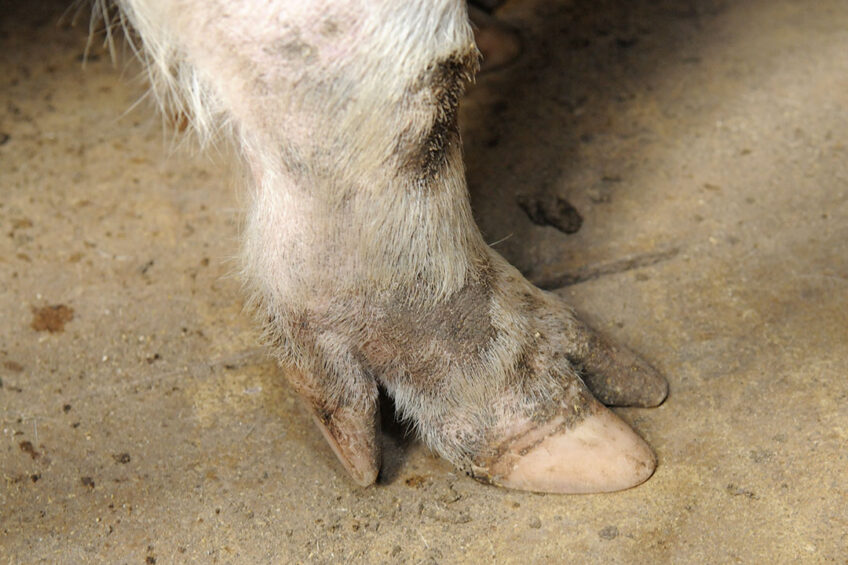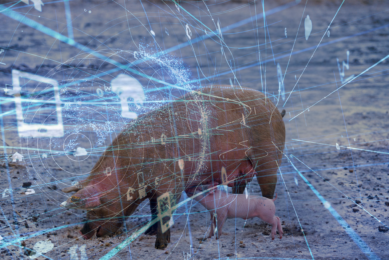Fewer lameness-related sow losses in 9 steps

Lameness is one of the major reasons for culling breeding stock. There are many methods which, when used together, can help keep sows in better shape for longer. Here are 9 aspects to consider to make sure lameness can be avoided for as long as possible.
Lameness is one of the most common reasons for premature culling of sows after reproductive failure. Lameness compromises sow welfare productivity and longevity and reduces sow herd efficiency and profitability. Almost 50% of sow culling due to lameness occurs in the developing gilt phase and first parity sows, which results in high replacement costs and lower number of piglets produced per sow lifetime. Therefore, timely identification of lameness is critical to minimise lameness and to reduce overall production costs.
Lameness is defined as a deviation from the normal gait caused by lesions, diseases and other factors such as genetics, nutrition, housing systems and management practices. However, the term lameness is used for a broad range of conditions, including feet and leg problems, conformational deficiencies, lameness, unsoundness, injuries and abscesses on the limbs. It is estimated that up to 48% of sows on a given farm are lame, and lameness costs approximately $ 230 million/year to the US swine industry. Thus, to prevent financial losses and welfare problems, preventive measures are required to minimise lameness occurrence.
 Tailor-made feed for breeding stock
Tailor-made feed for breeding stock
Genetic improvements have increased sow productivity, which in turn causes more stress in sows. Carrying more piglets puts more pressure on a sow’s skeletal system, and greater mobilisation of calcium, phosphorus and other minerals from the bones to the bloodstream is required to support milk production. Therefore, a tailored feeding programme needs to be applied based on controlling feed intake and daily gain while optimising gilt nutrition to ensure the building of a strong skeletal system.
 Genetics with structural soundness
Genetics with structural soundness
Preventing lameness starts with selecting replacement gilts with feet and leg soundness and integrity. Good structural conformation allows females to better compete in group housing situations and enhances sow herd retention. Furthermore, offspring from replacement gilts with proper feet and leg conformation will result in a greater percentage of full-value market hogs sold during the grow-finish phase. However, training individuals to select replacement gilts accurately can be challenging.
 Decent flooring to reduce injuries
Decent flooring to reduce injuries
Ascending infection caused by damage to the foot and hoof is a leading cause of sow lameness. Sow barns built for gestation stalls have a wide slat gap, and when the barns convert to group housing the gap is wide enough for a sow to get her toes stuck and damage her hoof. In addition, good flooring is essential to prevent injury at all stages of production. Therefore, refraining from mixing animals on the poor-quality flooring, replacing inappropriate slat gaps, providing solid footing for mixing – preferably bedded, and moving sows to the gestation pen two to three days later can reduce injuries occurring with group-housed sows.
Consistent observation of sows should be a regular management routine to detect locomotion problems as they develop
 Consistent observation of sows
Consistent observation of sows
Knowledge of lameness extent within a herd is the first step to understand the problem and develop a solution. Therefore, on-farm monitoring of sows is essential for timely detection of lameness before the problem progresses or the infection spreads deeper into the tissue and joints and becomes unresolvable. Sows tend to hide or manage to survive with lameness for some time until it becomes severe. Consistent observation of sows should be a regular management routine to detect locomotion problems as they develop. Observing sows moving from gestation into farrowing or from farrowing into breeding is an opportunity to detect locomotion problems. Close observation of sows after mixing should be performed to ensure no lameness has developed from injuries after fighting. Advancement in precision technology will enable swine producers to monitor sows in real time to identify lameness.
 Proactive treatment
Proactive treatment
Determining the most common causes of lameness, characterising symptoms and providing tailored treatments may help alleviate sow losses due to lameness. In some cases, providing lame sows with two doses of a non-steroidal anti-inflammatory, a rubber mat and corrective hoof trimming to restore hoof conformation at eight weeks gestation reduces the number of sows showing lameness and the severity of lameness.
 Tracking where lameness is most found
Tracking where lameness is most found
Flooring areas around cool cells are more likely to provide slippery conditions. Additionally, in areas where access panels exist over manure valves and other equipment, sharp corners can injure the hoof. It is recommended to focus on the areas where lameness occurs more frequently and fix any issue found.
 Paying attention to sows with extreme condition
Paying attention to sows with extreme condition
Over-conditioning is associated with heel bruises, and under-conditioning is associated with other hoof lesions and shoulder sores. However, it is unknown whether under-conditioning leads to nutritional compromise of the hoof or rather hoof lesions reduce feed intake. It is suggested to focus more on a subset of sows.
 Corrective trimming
Corrective trimming
Corrective trimming may be useful to correct hoof length and toe angle to reduce the excess tension or compression between the hoof horn and the bone underneath, so that blood supply is uncompromised. Hoof trimming requires restraint of the animal, and various crates are used to lift the sow for inspection while allowing the feet to hang through the bottom of the crate for trimming.
Rubber mat placement decreases the risk of lameness developing and encourages sows to stand up more frequently and lie down more often
 Altering sow environment
Altering sow environment
Another approach to prevent lameness is to change the environment to improve sow comfort. Rubber mat placement decreases the risk of lameness developing and encourages sows to stand up more frequently and lie down more often. However, it is unknown if using a rubber mat reduces lameness severity in previously identified lame sows.
Conclusion
Reducing sow lameness requires a multifaceted approach. It is important to keep lameness at a manageable level and maintain normal removal rates. Furthermore, it is essential to motivate farm crew and empower them to influence this issue and reduce the number of sows identified as lame. Lameness is a multifactorial condition, and it is challenging to determine the cause for each case; therefore, it is difficult to find the proper treatment method. Moreover, further research is needed to explore alternatives to improve sow comfort, to reduce lameness, to enhance overall productivity and welfare and to increase farm profitability over the coming years.











